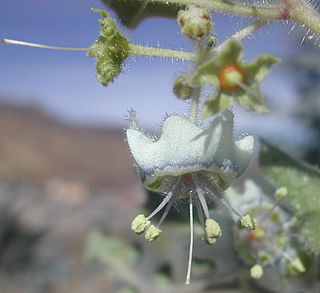Aegiphila cordifolia is a species of flowering plant in the family Lamiaceae. It is endemic to Peru, where it occurs in the Amazon rainforest. It is sometimes found in disturbed habitat.
Solanum ternatum is a species of flowering plant in the family Solanaceae. Its natural habitat is subtropical or tropical moist montane forests.

Fabiana imbricata, vernacular names pichi, palo piche, or false heath, is a species of flowering plant in the family Solanaceae. It is native to dry upland slopes in the foothills of the southern Andes of Chile and Argentina. Growing to 2.5 m tall and wide, it is a frost-hardy, heath-like evergreen mound-forming shrub. It has needle-like leaves and small white, tubular flowers in early summer.

Ismene, or Peruvian daffodil, is a genus of South American plants in the Amaryllis family. The species are native to Peru and Ecuador and widely cultivated elsewhere as ornamentals because of their large, showy flowers.

Sobralia dichotoma, is a species of flowering plant in the family Orchidaceae. It is native to Colombia, Ecuador, Peru and Bolivia.

Solanum crispum is a species of flowering plant in the family Solanaceae. It is native to Chile and Peru. Common names include Chilean potato vine, Chilean nightshade, Chilean potato tree and potato vine. Growing to 6 m (20 ft) tall, it is a semi-evergreen, woody-stemmed climbing plant. The small blue fragrant flowers, 2.5 cm in diameter, with prominent yellow ovaries, appear in clusters in summer. They resemble those of the closely related potato. Very small poisonous berries are produced in autumn. The berries start out green, then yellow-orange, and finally purple. The leaves are oval.

Tillandsia capillaris is a species of flowering plant in the family Bromeliaceae. This species is native to southern and western South America.

Tillandsia virescens is a species of flowering plant in the family Bromeliaceae. This species is native to Argentina, Bolivia, Chile and Peru. It was first described in 1802.

Tillandsia purpurea is a species of flowering plant in the family Bromeliaceae. It is endemic to Peru, first described by Ruiz and Pavón in 1802.

Buddleja diffusa is a species of flowering plant in the family Scrophulariaceae. It is endemic to central Peru and northern Argentina, growing on dry hillsides above rivers and creeks at altitudes of 1000–1900 m; it was first described and named by Ruiz and Pavon in 1798.

Brugmansia sanguinea, the red angel's trumpet, is a species of South American flowering shrub or small tree belonging to the genus Brugmansia in tribe Datureae of subfamily Solanoideae of the nightshade family Solanaceae. It has been cultivated and used as an entheogen for shamanic purposes by the South American Natives for centuries - possibly even millennia.

Clinanthus is a genus of bulbous plants in the family Amaryllidaceae. It is found in western South America, including Ecuador, Peru, Bolivia, north Chile and north west Argentina.

Jaltomata is a genus of plants in the family Solanaceae. According to molecular phylogenies, Jaltomata is the sister genus to Solanum, which includes tomato, potato, and eggplant. Jaltomata has a neotropical distribution, in that species occur from the United States southwest through Latin America, and into the Andean region of South America. Species encompass a wide range of vegetative and reproductive trait variation, including growth habit, floral size, shape and color, as well as fruit size and color. The fruits of some of the species are eaten by humans in Latin and South America. Depending on the species, fruits may be red, green, orange, or dark purple.

Jaltomata procumbens, the creeping false holly, is a plant species native to Arizona, USA, Mexico, Central America, Colombia, Ecuador, and Venezuela. It grows as a weed in agricultural fields and other disturbed locations, but in many places the people protect it because of the edible fruits it produces.

Jaltomata weberbaueri is a plant species native to Peru. It grows on rocky hillsides at elevations less than 1800 m.

Jaltomata cuyasensis is a plant species native to Peru. It grows on rocky hillsides at elevations less than 1800 m.

Jaltomata lojae is a plant species native to Peru and Ecuador.

Solanum grandiflorum is a species of evergreen tree or treelet in the family Solanaceae. It is native to the wet lowland forests of the Amazon Basin; currently reported in Bolivia, Brazil, Colombia, Ecuador and Peru at 150–1600 meters above sea level.

Schizanthus pinnatus, called butterfly flower or poor man's orchid, names it shares with other members of its genus, is a species of flowering plant in the nightshade family, Solanaceae. It is native to Chile and naturalized elsewhere. It has gained the Royal Horticultural Society's Award of Garden Merit as an ornamental.

Jaltomata cajacayensis is a plant species native to Peru. The name comes from the Cajacay District, where it was recognized by Mione as a new species.

















